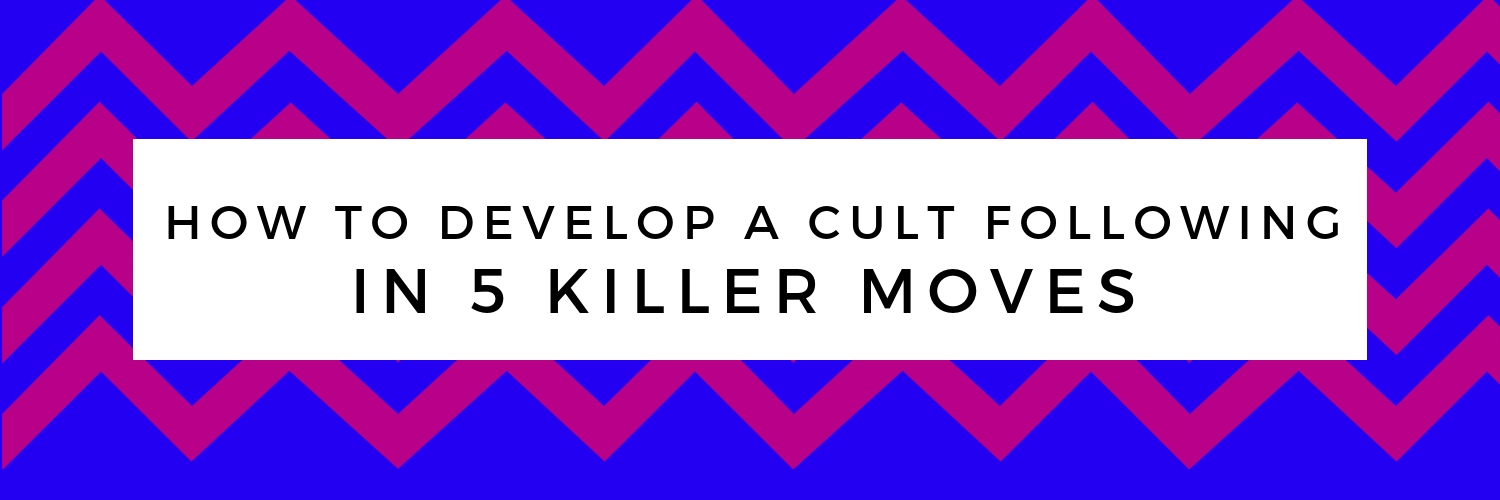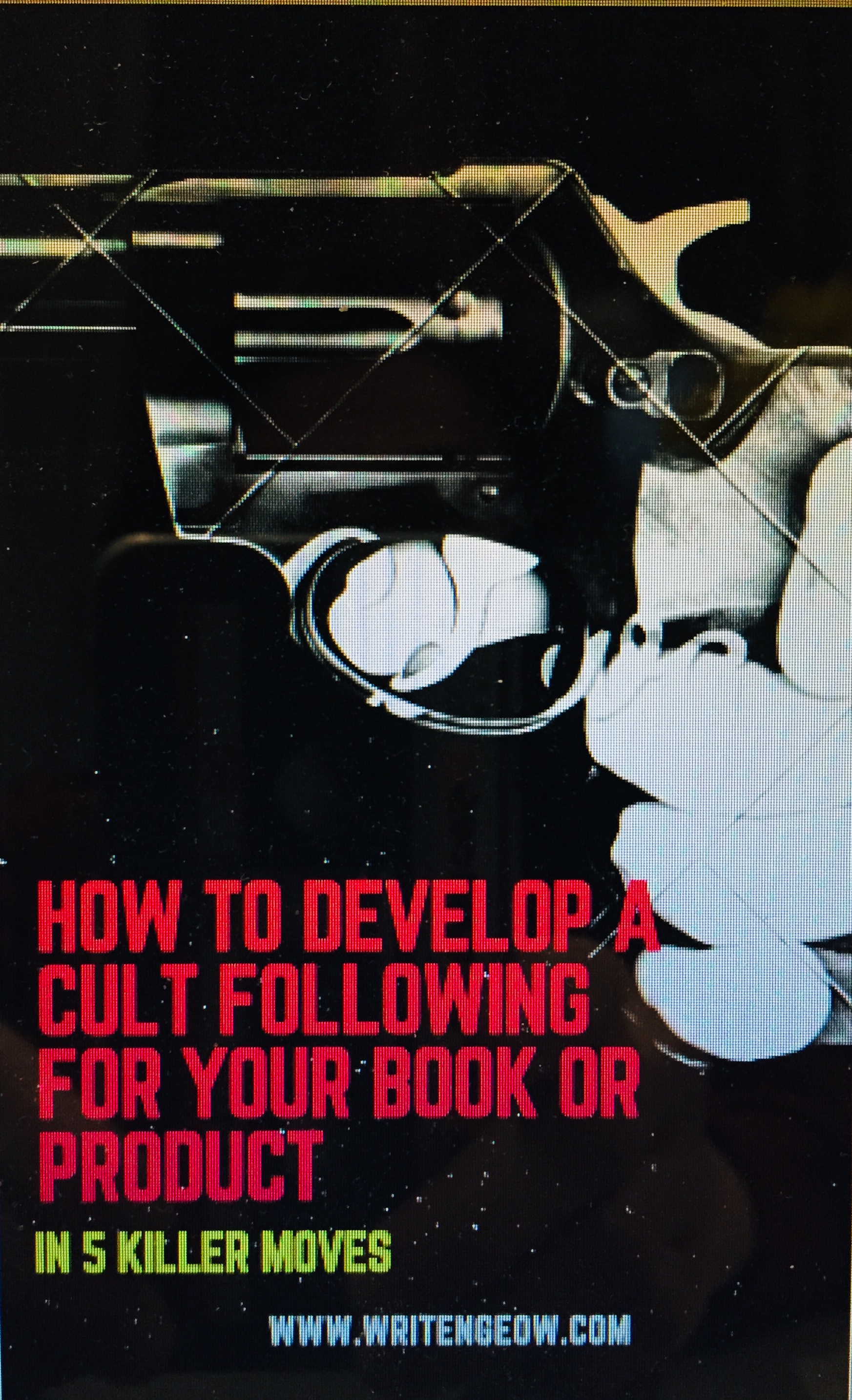… for your book or product, with exercises to try out.
Everybody knows at least 5 cult classics without even thinking. These are 5 of mine off the top of my head: Pulp Fiction, Trainspotting, 50 Shades, Zen and the Art of Motorcycle Maintenance, The Secret History. How did they become cults? How do you attract passionate devotees? Followers who adore your product which is then referred to as a cult classic?
If you have created a product such as a book, film, game or any cultural body of work, it becomes its own entity. I am going to refer to your work of art and culture as a product because that is what it is. Without the artist there is no art.
What are the elements of a cult classic?
 1. It has to have secrets.
1. It has to have secrets.
It has to be slightly odd and obscure but not that obscure. It has to be indie, organic, grass roots origin, not some megalomaniac machine-made slick corporate hub. Secrets must be built into your product which could be small details, language or stylistic elements. One of my strongest tips is having a secret language (eg A Clockwork Orange).  Mine is the modern vernacular. Slang. No one will know this unless they have read my books (except you, because I’m telling you now). My first novel was partly written in dialect or patois which is made up. My second was written in American slang of the 80s. Some of it totally imaginary, some of it true:
Mine is the modern vernacular. Slang. No one will know this unless they have read my books (except you, because I’m telling you now). My first novel was partly written in dialect or patois which is made up. My second was written in American slang of the 80s. Some of it totally imaginary, some of it true:
“wooden kimono” = coffin
“meat wagon” = ambulance
“shutter juice” = tears
These secrets have to be a bit weird and not immediately prominent yet having an impact. It could be codes and ciphers a la Dan Brown. It could be an enormous twist like in Fight Club, Se7en, The Usual Suspects, Gone Girl. It could be simply a world that is so well-built and rich the audience does not want to leave it eg Harry Potter, 50 Shades. It could be a symbol. eg the rose in The Name of the Rose. Through all my novels including the third one I am currently writing, there is a recurrent motif (clue: it is a symbol of fear) but I cannot divulge yet because the third one is still being written and in time the symbol or leitmotif will be made evident. Only a reader who has and will read all 3 of my books will suddenly go “OMG, ahaha, I get it” when they finally twig. My last tip is using stylistic elements. As a designer, I have a sense of the look and feel before I even touch my notebook. If the styling is strong, the secrets are strong (eg Pulp Fiction). They will be absorbed into the subconscious through a gradual process because the whole point is it develops ideas inside you. The word culture is from the Latin colere, to grow and cultivate the mind, faculties, or manners. Exercise: what is the secret ingredient in your product? How do you grow this secret? Keep this to yourself. It’s a secret.
2. It has to have a vision.
Do not be a sheep yourself. If you are a sheep, then why would other sheep follow you? Your vision has to be your big theme. It is all-consuming, a madness, a compulsion. It is SO appealing and appalling to you that it will appeal to and appall others. If you do not believe in it yourself, why should they? For example: my novel 1980s crime noir Heart of Glass’s big theme is desire. Due to the overwhelming nature of desire, greed and ambition, it is debatable if the characters’ motivations are good or bad, if the plot is right or wrong. Cult classics should have NO moral overtones or judgement because they are about the extreme extension of reality and human nature vs our fantasies. Who bloody cares if Kaizer Sozay of The Usual Suspects is a good or bad guy, does it even matter? The thing is he got you, and you got him. Cults are about the obsessive and obsessed, and ultimately, about you. Exercise: What is the most important thing to you about this product and what is your message? Keep this to one or two words max. eg Love, Grief, Stupidity, Childhood, Faith etc.
3. It has to be a mutual investment.
Like any work of art in the market, it is an investment. IT has a value. YOU have a value. Do not underestimate the power of ideas and originality. An artist should explore like-minded artists. Invest time, energy and money. If you do not know any cults, find them. If you spot them, they will spot you back. The same rule applies: if you do not invest in exploration of cults, why should they explore your cult? Exercise: Find those who are into the same big themes or secrets mentioned in item 1. Follow them. If you write memoirs, find memoir authors or diarists. If you have a Nicaraguan coffee bean business, find diverse indie cafes. If you are obscure, find the obscure.
4. It has to have your positive values.
It has to show a bit of you, your human factor and values. Show them who you are (no, who you really are, not the bland corporate bigwig smiling like a mask but the earnest ingenue that you really are) why you care about your art so much. They want to see you bleed for your art, just like Jesus died on the cross. Write blog articles, tell social media, make your thoughts public. Take photos of your work in progress, failures and triumphs. Show that in some way you can help others in your position, fellow sufferers who do not realise they are not alone. Chipotle is a US food chain with a cult following. They put up signs to show where their chickens come from each week, and print inspirational sayings on bags. Another one is Taylor Swift. On her Insta, you can see her glam mates and her sing “Blank Space” in front of 60,000 people. But she also posts photos of her first gig on a small fold-out stage in a park with a flimsy banner that says “Taylor Swift” in red. I do not hide the hardships I have suffered. I spent 12 years (“12 years a slave”) trying to get my first novel published, facing 80-90 rejections until it won an international award and publishing deal. I spent 7 years doing the same with the second novel, this time with “only” around 40-50 rejections. Let them see your devotion and diligence. Build trust and build brand loyalty. Exercise: write down 3 things that you have found hardest about getting your product out (obstacles in your way) and then 3 ways you used to handle them.
5. It has to be a brand.
Brand is niche, ethos, club, cartel, coterie: there are many ways to describe a cult. A cult brand is genre-free, prejudice-free, unable to be pigeonholed or categorised. It is timeless and that is why it becomes a classic.

You don’t know why people like it (eg The Grand Budapest Hotel), love it (Fargo) or hate it (eg American Psycho):
“Ya gotta live it to believe it, believe it ta love it.” – Heart of Glass
When I was writing my books, I did not know what I was aiming to do. I just knew I write irreverently, contentiously, cultishly. Fast dialogue, noir, straight no bullshit, anti-hero, underdog stuff. I am into slightly gritty, dark, humorous, believable yet unbelievable characters and plot. You keep thinking about them, discussing them, and eventually you want to become the characters. Exercise A: Who are the people you’d want to invite to your club/cartel/coterie/soiree, if your room is small? Write down as many details as you can about these guests. Their age, ethnicity, choice of food, clothes, music, books, TV, movies. Exercise B: How do your characters appeal to your cult members ie. your tribe? Are they similar or dissimilar and why will your Club members want to become your characters?
What is your cult product or brand that is irresistible and esoteric? How have you suffered for your art? I would be very excited to hear from you. Drop me an email, comment or tweet me. Please share if you enjoyed this article.
Ivy Ngeow was born and raised in Johor Bahru, Malaysia. She is of Chinese origin and the author of two novels. Cry of the Flying Rhino (Proverse Hong Kong), winner of 2016 International Proverse Prize, is her debut set in Malaysia and Borneo. Her second novel Heart of Glass (Unbound UK) is noir fiction set in Chicago and Macau. She is fond of margaritas, seafood tacos, thrift stores, Americana and all things cultish and vintage. She lives in London in her ‘third culture’ and is working on her third novel.
#heartofglass #cryoftheflyingrhino Tweet me: @ivyngeow

